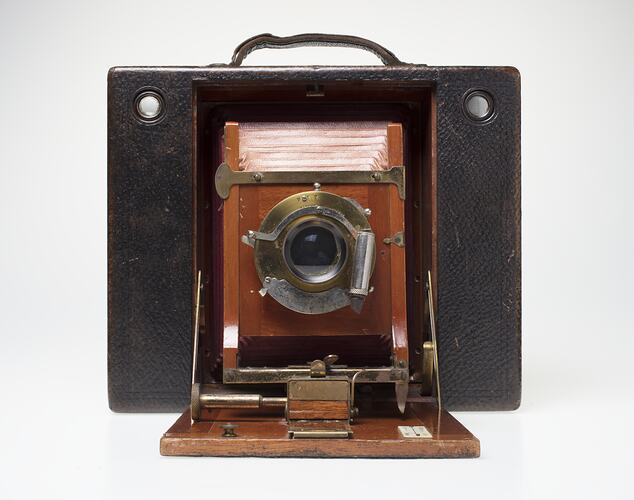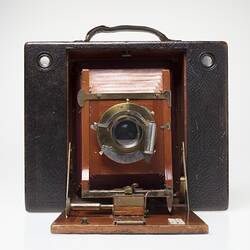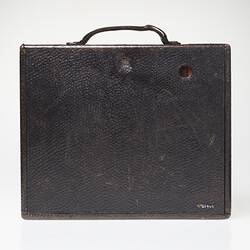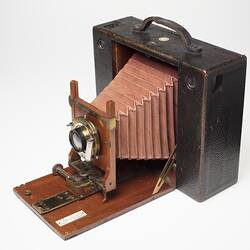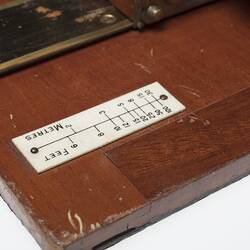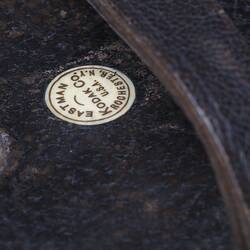Summary
The No. 5 Cartridge Kodak camera was manufactured by Eastman Kodak Co., Rochester, N.Y., U.S.A., circa 1900.
The camera has a Bausch and Lomb Rapid Rectilinear f.8 lens and an Eastman Triple Action Pneumatic shutter, the F.P.K. Automatic, which was one of the early Kodak designed shutters. It takes 115 roll film. The name 'cartridge' was a reference to the fact that a roll of 115mm film, used for this camera, looked a little like a shotgun cartridge. The roll film allowed for daylight loading of the film into the camera, a relatively new innovation for photography at the time. The No. 5 Cartridge Kodak was manufactured between the years 1898 to 1907. It was patented in 1895 and 1891.
There are U. S. calibrations and rack and pinion focusing. It has a time, bulb and instant [TBI], automatic shutter with a lever as well as a cylinder pneumatic release by the side of the lens. The camera takes 5" x 7" [127mm by 177mm] photographs, The body of the camera has a drop front which acts as a rail for the bellows when opened and laid flat. There are two built-in view-finders, one on either side of the camera. Adjustable aperture. Red leather bellows and mahogany interior.
Physical Description
Folding camera in dark-brown leather-covered wooden body with red leather bellows. Brass and nickel plated lens mounted onto a wooden lens standard and base board. Chrome valve for pneumatic shutter fitted on face of the lens. Contains two wooden take-up spools in the interior back of camera. Leather carry handle fitted to the top plate, which bears the Eastman Kodak name.
More Information
-
Collecting Areas
-
Acquisition Information
Donation from Miss M. P. Laver, 07 Jun 1941
-
Maker
Eastman Kodak Company, Rochester, New York, United States of America, circa 1900
-
Maker of Components
-
Inscriptions
Inscribed on ivory coloured nameplate on top of camera: 'EASTMAN KODAK CO. / ROCHESTER N.Y. / U.S.A.'. Inscribed on ivory coloured nameplate on inside of back cover: 'No. 5 CARTRIDGE KODAK / MADE BY / EASTMAN KODAK CO., / ROCHESTER, N. Y. U.S.A. / PATENTED / MAY 5 1885 DEC. 1 1891...'.
-
Model Name or Number
-
Brand Names
-
Classification
-
Category
-
Discipline
-
Type of item
-
Overall Dimensions
265 mm (Width), 240 mm (Depth), 310 mm (Height)
-
Keywords
Camera Accessories, Camera Lenses, Lens, Lenses, Photographic Equipment, Photography, Bellows, Optical Technology, Leather Products
